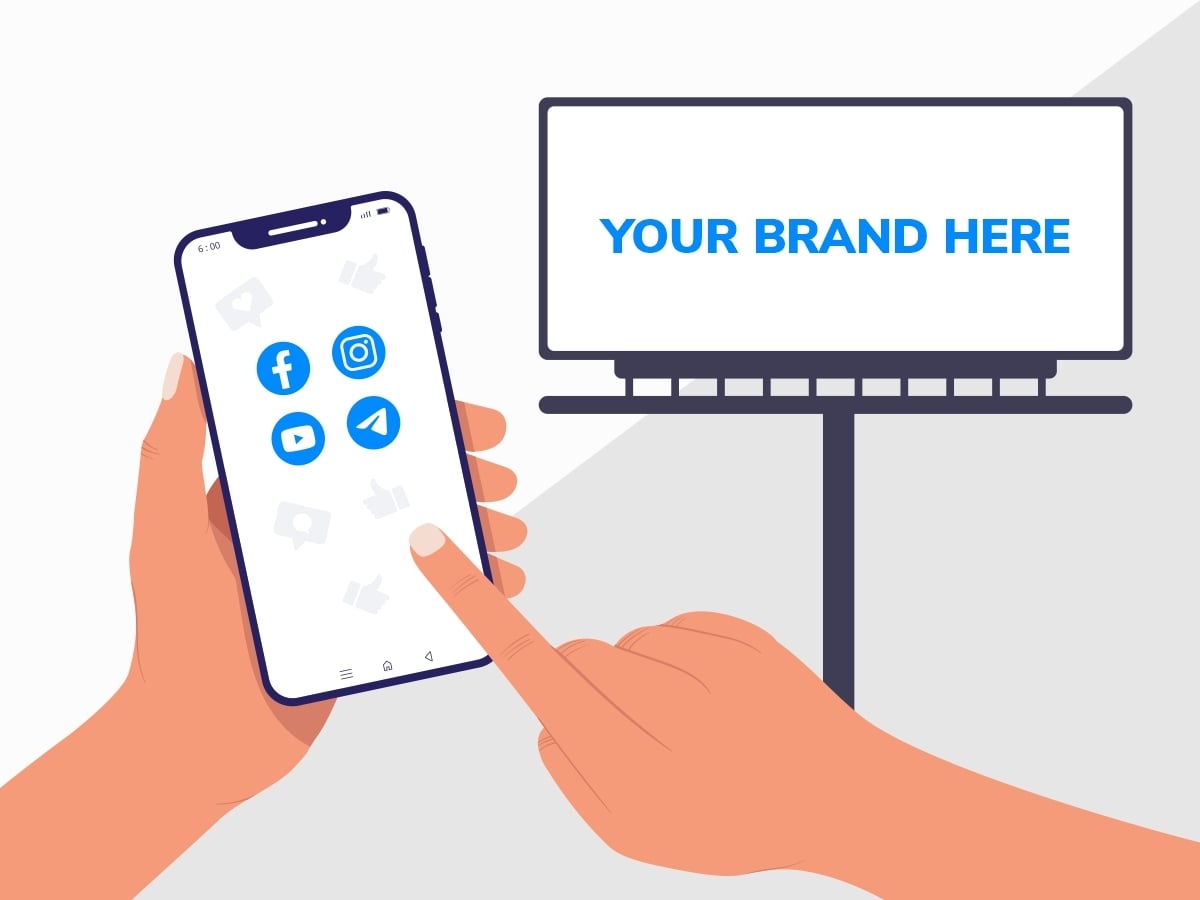Memes. Reposts. Viral videos. With the constant movement, it’s easy to get caught up in the allure of social media advertising. Yet, amidst the digital frenzy, traditional media like billboards and other forms of outdoor media still stands its ground. It goes without saying that we’ve witnessed firsthand the effectiveness of traditional advertising methods.
Don’t get us wrong; we’re not trying to negate the power that social media advertising can have when done right. We’re here to remind businesses not to allow the bells and whistles of social media to overshadow the enduring strength of traditional advertising.
Let’s dive into the popular debate of traditional media versus social media for advertising, by way of pros and cons. Read on to learn more about why we firmly believe that traditional media (such as billboards and other forms of outdoor advertising) still holds the crown.
Here’s what we’ll cover:
- Social media advertising pros
- Social media advertising cons
- Traditional media advertising pros
- Traditional media advertising cons
- The verdict: social media vs. traditional media
Social Media Advertising Pros
Targeted Advertising
Social media platforms offer advanced targeting options, allowing advertisers to reach specific demographics, interests, and consumer behaviors. When done right, social media targeting can help ensure that you’re not wasting ad dollars trying to reach people outside of your target audience.
Cost-Effective
Social media advertising often requires lower initial investment when compared to other advertising channels, making it accessible to businesses of all sizes, including startups and small businesses. However, if you don’t keep a close eye on your bidding options as cost-per-click can add up quickly.

Engagement and Interaction
Social media advertising enables direct engagement with audiences through likes, comments, shares, and messages — building relationships with customers. You can often see how people feel about your ad in real-time, which can allow for quick tweaks i needed.
Data Analytics
Social media platforms provide analytics tools that offer insights into campaign performance, audience demographics, and engagement metrics, allowing advertisers to optimize their strategies for better results.
Social Media Advertising Cons
Saturation and Competition
The crowded nature of social media platforms (77% of businesses use social media to reach existing and potential customers) means that advertisers are competing for the attention of users, leading to ad fatigue and reduced effectiveness over time.
Ad Blindness
Users are increasingly ignoring or scrolling past ads on social media feeds, especially if they perceive them as intrusive or irrelevant to their interests. More than a third of Americans find social media ads annoying — even those that target them based on their interests.
Algorithm Changes
Social media platforms frequently update their algorithms, which can impact the visibility and reach of ads, leading to fluctuations in performance and the need for ongoing optimization.
Rising Ad Costs
While social media advertising can be cost-effective compared to other advertising channels, the cost of advertising on popular platforms like Facebook and Instagram has been steadily increasing, particularly as competition grows.
Negative Feedback and Trolling
Social media ads are subject to public feedback and comments, which can sometimes be negative or inflammatory, potentially damaging a brand’s reputation if not managed effectively.
Platform Dependency
Relying solely on social media advertising means being at the mercy of platform policies and changes, with the risk of account suspensions, ad disapprovals, or algorithm updates affecting campaign performance.
Short Attention Spans
Users on social media platforms have short attention spans and may quickly scroll past ads without engaging, requiring advertisers to create compelling content that grabs attention within seconds.

Traditional Media Advertising Pros
Tangible Presence
Unlike fleeting social media posts that disappear in a matter of seconds, traditional media offers a tangible presence that captivates audiences day in and day out. With billboards, your message isn’t lost in a sea of digital noise; it’s front and center, commanding attention and leaving a lasting impression on passersby.
Targeted Reach
Social media platforms often fall short when it comes to reaching specific demographics in a localized area. Traditional media, on the other hand, allows for hyper-localized targeting with strategically placed billboards in key locations. Whether you’re targeting commuters on their daily drive or shoppers in a specific neighborhood, billboards offer unparalleled precision and reach.
Uninterrupted Engagement
In a time of ad blockers and algorithm changes, getting your message across on social media can feel like an uphill battle. With traditional media, there are no interruptions or competing distractions. When consumers encounter your billboard, they have no choice but to engage with your message, leading to higher retention and brand recall.
In other words, billboard advertising is the only form of advertising that people can’t turn off!
Timeless Appeal
While social media trends come and go at the speed of light, traditional media stands the test of time. A well-designed billboard can leave a lasting impression that resonates with audiences for years to come. Whether it’s a memorable slogan, striking imagery, or clever design, traditional media offers timeless appeal that transcends fleeting digital trends.
Trust and Credibility
With fake news and online scams abound, trust and credibility are more important than ever. Traditional media, with its established presence and vetted content, instills a sense of trustworthiness that is often lacking in the digital realm. When consumers see your brand displayed on a billboard, they perceive it as reputable and reliable.

Traditional Media Advertising Cons
Limited Interaction Options
Unlike social media’s likes, comments, and shares, billboards don’t have an immediate interaction feature. That means it might take a little bit more work to gauge how people interacted with your ad whether it’s a website visit, phone call, visit to your business location, or something else.
More Effort to Track ROI
It can require more work to track the exact return on investment (ROI) of traditional advertising methods compared to digital channels. It’s definitely not impossible, but it’s not as simple as looking at an insights dashboard on a social platform. (On a related note, ads that stay up longer tend to have a better ROI. We recommend running your ad for at least 12 weeks.)
External Factors
This can go both ways. If a highway is undergoing construction, there may be less drivers using that route, meaning that less people are encountering your billboard during its campaign. However, other factors like holidays or major events can mean that there are more people on the road. Even traffic (as annoying as it is) can result in longer dwell times and more time spent looking at your ad.
The Verdict: Social Media vs. Traditional Media
When we take into consideration all of the pros and cons above, traditional media remains an advertising force to be reckoned with. Social media undoubtedly has its merits, but traditional media continues to offer unparalleled advantages in terms of reach, engagement, and longevity.
So the next time you’re considering your advertising strategy, don’t overlook traditional media – because sometimes, the classics truly do reign supreme.
